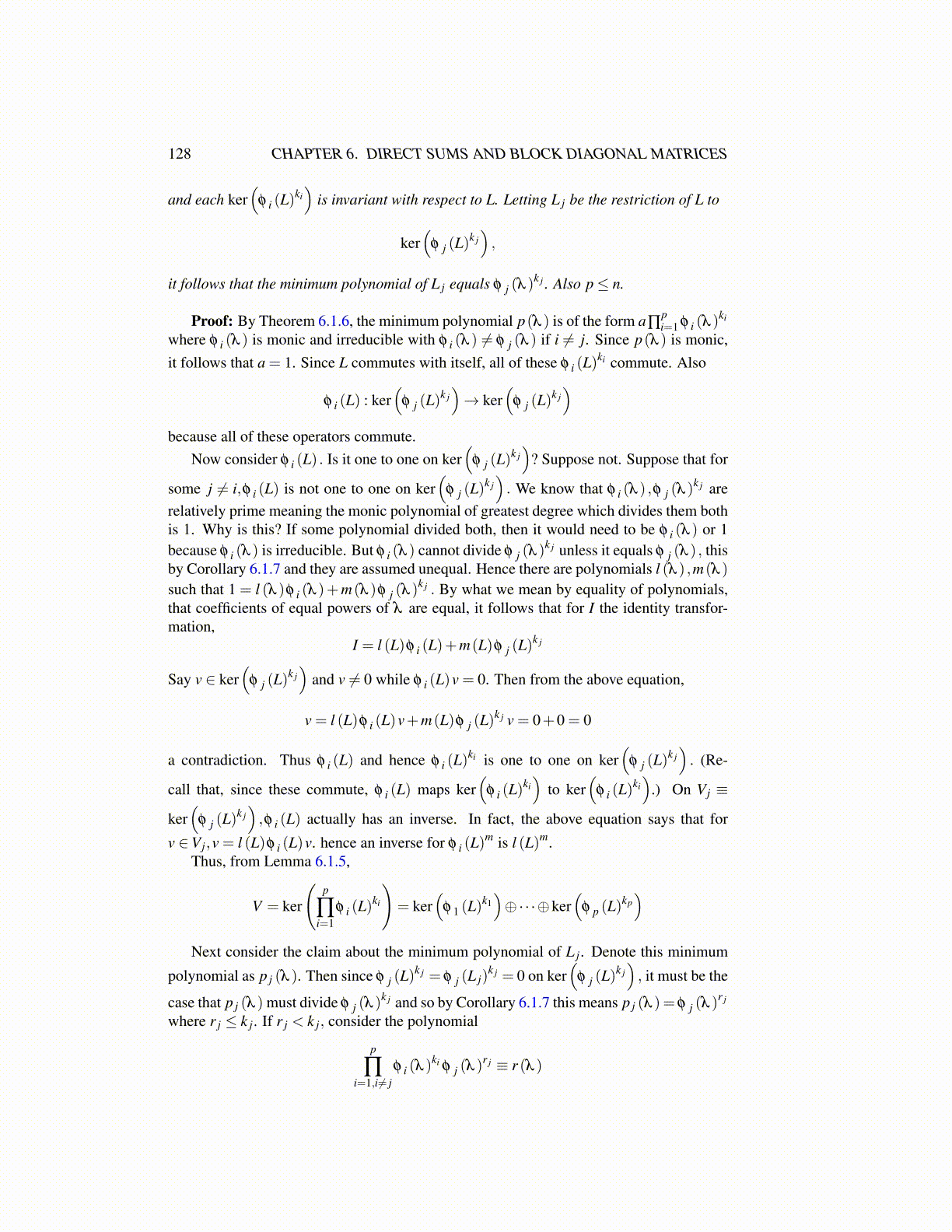
128 CHAPTER 6. DIRECT SUMS AND BLOCK DIAGONAL MATRICES
and each ker(
φ i (L)ki)
is invariant with respect to L. Letting L j be the restriction of L to
ker(
φ j (L)k j),
it follows that the minimum polynomial of L j equals φ j (λ )k j . Also p≤ n.
Proof: By Theorem 6.1.6, the minimum polynomial p(λ ) is of the form a∏pi=1 φ i (λ )
ki
where φ i (λ ) is monic and irreducible with φ i (λ ) ̸= φ j (λ ) if i ̸= j. Since p(λ ) is monic,it follows that a = 1. Since L commutes with itself, all of these φ i (L)
ki commute. Also
φ i (L) : ker(
φ j (L)k j)→ ker
(φ j (L)
k j)
because all of these operators commute.Now consider φ i (L) . Is it one to one on ker
(φ j (L)
k j)
? Suppose not. Suppose that for
some j ̸= i,φ i (L) is not one to one on ker(
φ j (L)k j). We know that φ i (λ ) ,φ j (λ )
k j arerelatively prime meaning the monic polynomial of greatest degree which divides them bothis 1. Why is this? If some polynomial divided both, then it would need to be φ i (λ ) or 1because φ i (λ ) is irreducible. But φ i (λ ) cannot divide φ j (λ )
k j unless it equals φ j (λ ) , thisby Corollary 6.1.7 and they are assumed unequal. Hence there are polynomials l (λ ) ,m(λ )
such that 1 = l (λ )φ i (λ )+m(λ )φ j (λ )k j . By what we mean by equality of polynomials,
that coefficients of equal powers of λ are equal, it follows that for I the identity transfor-mation,
I = l (L)φ i (L)+m(L)φ j (L)k j
Say v ∈ ker(
φ j (L)k j)
and v ̸= 0 while φ i (L)v = 0. Then from the above equation,
v = l (L)φ i (L)v+m(L)φ j (L)k j v = 0+0 = 0
a contradiction. Thus φ i (L) and hence φ i (L)ki is one to one on ker
(φ j (L)
k j). (Re-
call that, since these commute, φ i (L) maps ker(
φ i (L)ki)
to ker(
φ i (L)ki)
.) On Vj ≡
ker(
φ j (L)k j),φ i (L) actually has an inverse. In fact, the above equation says that for
v ∈Vj,v = l (L)φ i (L)v. hence an inverse for φ i (L)m is l (L)m.
Thus, from Lemma 6.1.5,
V = ker
(p
∏i=1
φ i (L)ki
)= ker
(φ 1 (L)
k1)⊕·· ·⊕ker
(φ p (L)
kp)
Next consider the claim about the minimum polynomial of L j. Denote this minimum
polynomial as p j (λ ). Then since φ j (L)k j = φ j (L j)
k j = 0 on ker(
φ j (L)k j), it must be the
case that p j (λ ) must divide φ j (λ )k j and so by Corollary 6.1.7 this means p j (λ ) = φ j (λ )
r j
where r j ≤ k j. If r j < k j, consider the polynomial
p
∏i=1,i̸= j
φ i (λ )ki φ j (λ )
r j ≡ r (λ )